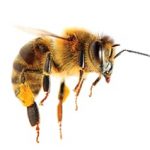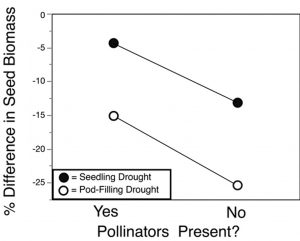Pollinators increase yield and mitigate drought impacts
KEY RESULT:
Pollinators increased canola yield by promoting earlier flowering and reducing loss associated with drought. However, pollinators were unable to compensate for suboptimal seeding rate or low nitrogen fertility.
PROJECT TITLE, PRINCIPAL INVESTIGATOR:
“Getting more bang for your buzz: Does pollination compensate for canola yield lost under sub-optimal soil moisture, nitrogen fertilization and/or seeding rates?” Ralph Cartar, University of Calgary
FUNDING:
Alberta Canola, Manitoba Canola Growers, SaskCanola, Alberta Beekeepers’ Commission
 Get more bang for your buzz. This project consisted of three experiments that investigated whether pollinators could help maintain yield under drought (which they could, to an extent) or while reducing inputs like fertilizer and seed (which they couldn’t).
Get more bang for your buzz. This project consisted of three experiments that investigated whether pollinators could help maintain yield under drought (which they could, to an extent) or while reducing inputs like fertilizer and seed (which they couldn’t).
Experiment 1: Higher yield with pollinators
In a greenhouse experiment, 23 varieties (9 open-pollinated and 14 hybrid) were grown in the presence or absence of pollinators. Total canola yield and quality were higher in canola plants exposed to insect pollination, even though the presence of pollinators reduced plant size. By shifting peak flowering earlier, pollinators increased yield, and reduced the crop’s dependency on aborted pods (scars) or later reproduction (branch pods).
Experiment 2: Pollinators increased yield by 20% during drought
In this greenhouse experiment comparing pollinators with non-pollinator treatments, canola was subjected to moisture stress by receiving 30 per cent of normal watering at the vegetative stage (from the fourth leaf to the first visible petal, called “seedling drought”) and the pod-filling stage (end of flowering to harvest, called “pod-filling drought”).
Pollinators reduced the negative effects of drought with approximately 20 per cent higher yield, regardless of whether the drought was experienced during the seedling or the pod-filling stage. The fitness “bump” provided by pollinators was accomplished primarily by shifting the plant’s flowering phenology earlier and narrower.
Experiment 3: Pollinators could not compensate for poor plant stands
This field experiment examined three treatments using four hybrid varieties of canola grown in 80 experimental plots at the AAFC Research Station in Beaverlodge, Alberta. Two plant spacing treatments (half of conventional at 75 seeds/m2 and conventional, 150 seeds/m2) and two fertilizer rates (none, conventional) were compared with pollinators present or absent. This was controlled using screen tents installed just before 10 per cent bloom.

In the field over two summers, pollinators did not buffer yield in the face of less costly inputs (lower seeding amounts, lower N fertilization). Instead, pollinators were usually associated with equal or lower yields relative to plants in a screen tent. Pollinators marginally reduced the oil content of unfertilized plants, and marginally reduced the protein content of fully fertilized plants.
The research found that nitrogen was the principal determinant of plant yield and seeding rate was the second biggest factor. Overall, the importance of pollinators in the Experiment 3 field trials was dwarfed by the strong driver of canola yield: nitrogen.





